![[VIDEO] Ultrasound-guided infiltration of the lumbar facets](https://drjordijimenez.com/imagen/100/100/imagenes-pagina/sindrome-facetario-lumbar-drjordijimenez (1).jpg)
- Home /
- EXERCISES /
- HIP EXERCISES /
- HIP ABDUCTOR MUSCLE STRENGTHENING EXERCISES
HIP ABDUCTOR MUSCLE STRENGTHENING EXERCISES
Frequently Asked Questions about the Hip Abductor Muscles
What are the hip abductor muscles?
They are a group of muscles located in the posterolateral part of the hip that allow the leg to move away from the body (abduction movement). They also play a key role in stabilizing the pelvis during activities such as walking, running, or standing on one leg.
What are the main abductor muscles?
The main ones are the gluteus medius, gluteus minimus, and tensor fasciae latae. They all work in coordination to control hip position and body balance.
Why is it important to strengthen the abductors?
Because these muscles ensure good pelvic stability, prevent compensatory movements, and protect joints such as the knees and the lumbar spine. They are essential for efficient and pain-free movement.
What are the consequences of having weak abductors?
Weakness of these muscles can cause pelvic instability, unsteady gait, overload on the lower back or knees, and an increased risk of falls, especially in older adults.
What types of injuries are related to weak abductors?
Some of the most common are iliotibial band syndrome, patellofemoral pain, trochanteric bursitis, and lower back problems. They can also affect technique in sports, increasing the risk of muscle injuries.
Does strengthening the abductors help prevent injuries?
Yes, because they stabilize the pelvis and improve lower-body alignment, which reduces stress on other joints and soft tissues.
Does abductor training improve athletic performance?
Absolutely. Strong abductors allow better control during direction changes, accelerations, decelerations, and maintaining balance during dynamic actions, which is fundamental in almost all sports.
Do these muscles influence balance and posture?
Yes. They are key to keeping the pelvis aligned, especially in single-leg support activities. Their proper function improves postural control and reduces the risk of falls or trips.
Can I train them at home without equipment?
Yes, many exercises can be done with bodyweight or with a resistance band. You don’t need expensive equipment, just proper technique and consistency.
How many times a week should I work these muscles?
Ideally, include abductor exercises 2 to 3 times a week, allowing rest days between sessions for good muscle recovery.
Can abductor training relieve lower back pain?
Yes. By stabilizing the pelvis and improving body mechanics, the load on the lumbar spine is reduced, which can help decrease discomfort and prevent relapses.
Is the abduction machine at the gym useful?
Yes, if used with proper technique and not as the only exercise. It is good for isolating the abductor muscles, but should be combined with other functional movements.
Are they important in injury rehabilitation?
Definitely. The abductors are often involved in many clinical conditions, so strengthening them is a key part of rehabilitation programs for the knee, hip, and back.
Are there any risks when working the abductors?
As with any muscle group, if trained excessively, with poor technique, or without control, overloads or injuries may occur. It is advisable to progress gradually and, if there is discomfort, consult a professional.
Hip Abductor Muscle Strengthening Exercises
Side-lying hip abduction exercise:
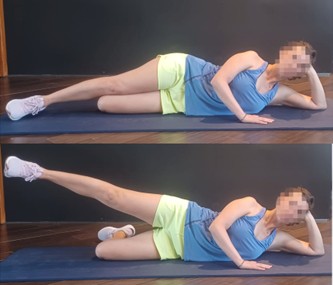
Lying on your side with the top leg extended upward. Lift the straight leg about 30–40 cm without bending. Hold for 5 seconds. Risk of tensor fasciae latae dominance if internal rotation of the leg is not controlled.
Perform:
- 10 repetitions.
- 3 sets daily.
Goals:
- Strengthen the hip abductors, especially the tensor fasciae latae if internal rotation is not controlled.
- Improve pelvis and hip stability.
Bridge exercise with leg lift:
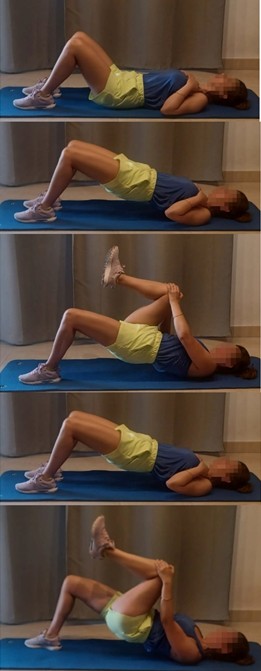
Lie on your back with knees bent and feet flat on the floor. From this position, lift your pelvis by contracting your glutes until forming a straight line from shoulders to knees. Once in the bridge position, lift one leg, keeping the knee bent at a 90° angle, without losing alignment or letting the pelvis drop. Hold the leg up for a few seconds and then lower it slowly, keeping the pelvis elevated. Repeat with the other leg.
Perform:
- 10 repetitions.
- 2–3 sets daily.
Goals:
- Strengthen the gluteus medius and other hip stabilizers.
- Strengthen the gluteus maximus of the supporting leg.
- Activate the hamstrings and posterior leg muscles.
- Improve lumbopelvic stability and core control.
- Prevent injuries due to misalignments or hip/pelvis weakness.
Bridge exercise with leg lift and knee-to-chest pull:

Advanced variation of the previous exercise. Lying on your back with knees bent and feet flat on the floor. Lift the pelvis by contracting the glutes until forming a straight line between shoulders and knees. From that bridge position, bring one knee toward the chest, holding it with your hands and applying a controlled pull, while the other leg remains in support. The pelvis must remain stable and elevated throughout the movement. Then lower the leg without resting the pelvis and repeat with the opposite leg.
Perform:
- 10 repetitions.
- 2–3 sets daily.
Goals:
- Strengthen the gluteus maximus and hamstrings of the supporting leg.
- Activate the gluteus medius and pelvic stabilizers.
- Improve lumbopelvic stability and core control.
- Prevent injuries due to misalignments or hip/pelvis weakness.
Lateral steps with band around thighs:
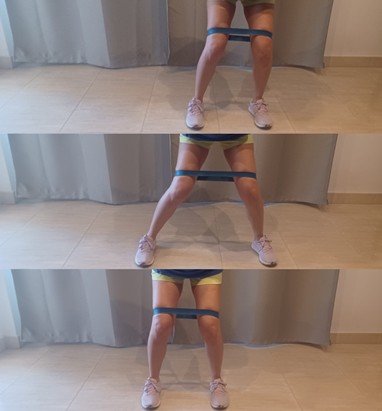
Take lateral steps while keeping a resistance band placed around the thighs, just above the knees. Perform in a semi-squat position, maintaining constant tension in the band throughout the movement.
Perform:
- 10–15 steps per side.
- 3–4 sets daily.
Goals:
- Activate and strengthen the gluteus medius, minimus, and TFL.
- Improve hip and knee stability.
- Prevent injuries due to misalignments or hip/pelvis weakness.
Lateral tap with band around thighs:

From a semi-squat position, with a resistance band placed just above the knees, keep one leg fixed while extending the other to the side, tapping the floor with the toe, then return to center. Repeat alternating sides.
Perform:
- 15 repetitions per side.
- 3 sets daily.
Goals:
- Activate and strengthen the gluteus medius, minimus, and TFL.
- Improve hip and knee stability.
- Prevent injuries due to misalignments or hip/pelvis weakness.
Anterior and posterior tap with band around thighs:

From a semi-squat position, with a resistance band placed just above the knees, keep one leg fixed while extending the other forward (anterior tap) and then backward (posterior tap), gently touching the floor with the toe each time. Perform in a controlled way to maintain band tension. Keep torso stable and band always tight.
Perform:
- 10 repetitions per side (each includes one forward and one backward tap).
- 3 sets daily.
Goals:
- Activate and strengthen the gluteus medius, minimus, and TFL.
- Improve hip and knee stability.
- Prevent injuries due to misalignments or hip/pelvis weakness.
Lateral walk with band around thighs:
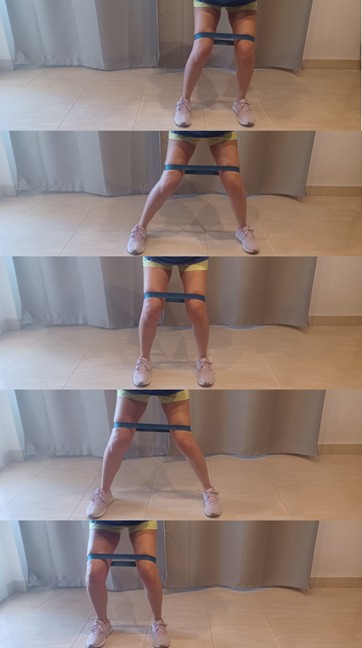
From a semi-squat position, with a resistance band placed just above the knees, take consecutive lateral steps in one direction, maintaining constant tension in the band and torso control. Then repeat in the opposite direction.
Perform:
- 10 steps per side.
- 3 sets daily.
Goals:
- Activate and strengthen the gluteus medius, minimus, and TFL.
- Improve hip and knee stability.
- Prevent injuries due to misalignments or hip/pelvis weakness.
Lateral tap with band around ankles:
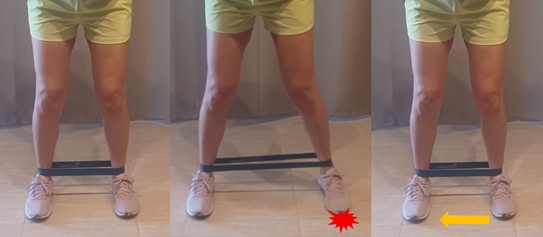
Standing with a resistance band placed around the ankles, keep one leg fixed while extending the other to the side, tapping the floor with the toe, then return to center. Repeat in a controlled way, maintaining band tension.
Perform:
- 15 repetitions per side.
- 3 sets daily.
Goals:
- Activate and strengthen the gluteus medius, minimus, and TFL.
- Improve hip and knee stability.
- Prevent injuries due to misalignments or hip/pelvis weakness.
Lateral walk with band around ankles:
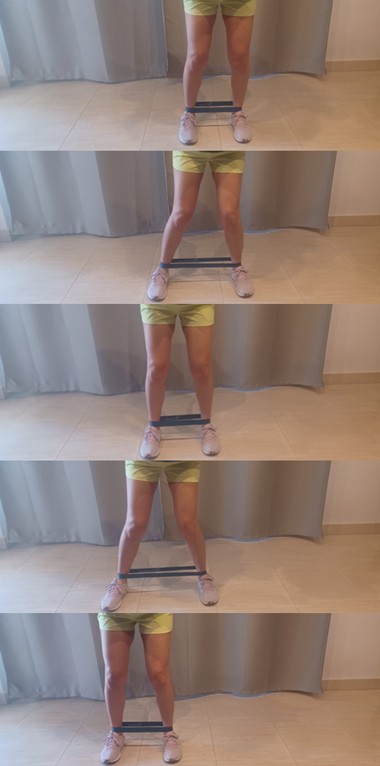
From a semi-squat position, with a resistance band placed around the ankles, take controlled lateral steps in one direction, keeping band tension throughout. Then repeat in the opposite direction.
Perform:
- 10 steps per side.
- 3 sets daily.
Goals:
- Activate and strengthen the gluteus medius, minimus, and TFL.
- Improve hip and knee stability.
- Prevent injuries due to misalignments or hip/pelvis weakness.
>> DOWNLOAD THESE HIP ABDUCTOR STRENGTHENING EXERCISES:  Hip-Abductor-Exercises-drjordijimenez.PDF <<
Hip-Abductor-Exercises-drjordijimenez.PDF <<
>> DOWNLOAD A HIP EXERCISE COMPLIANCE CALENDAR:  hip-exercise-compliance-calendar-drjordijimenez.PDF <<
hip-exercise-compliance-calendar-drjordijimenez.PDF <<
Make an Appointment with Dr. Jordi Jiménez. He will see you at the Palma de Mallorca center and help you recover your quality of life.

![[VIDEO] Ultrasound-guided infiltration of the hip joint](https://drjordijimenez.com/imagen/100/100/Imagenes/valgo-dinamico-rodilla-drjordijimenez.jpg)
